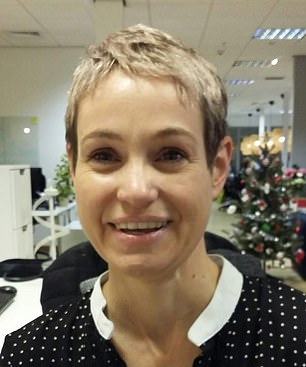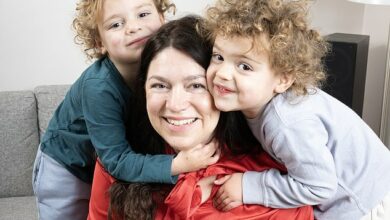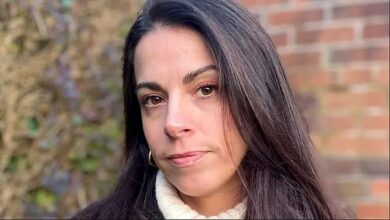I beat leukemia as a child, but the treatment that saved me left me with oral cancer at age 27… and brain tumors at age 45.





There aren’t many people who can say they’ve been living with cancer for almost 43 years. Katie Thorington, 45, from Peterborough, is one such person.
When she was just two, she was diagnosed with the blood cancer leukaemia, the most common form of cancer in children, with around 650 new cases diagnosed in British children and young adults each year.
Six years later, at age eight, she went into remission, but at age 13 she discovered that the powerful drugs and radiation therapy were damaging her brain, causing her to develop epilepsy.
Worse, less than two decades after she was declared cancer-free, she was again diagnosed with a form of the disease linked to childhood cancer treatment, this time an extremely rare tumor that develops in the jaw.
Now in her mid-forties, doctors have discovered tumors in her brain.

The project is supported by former childhood cancer patients such as Katie Thorington who, in a tragic twist, developed secondary cancer from the treatments used to stop her childhood leukaemia. Katie is pictured here with her father
But there is hope on the horizon for thousands of patients like her who are dealing with long-term effects of childhood cancer treatment.
Cancer Research UK, the country’s leading cancer charity, has launched a new £28 million research initiative that will help develop new, specific therapies that are gentle enough for children.
Currently, there are few specific medications and treatments available for children with cancer.
Most childhood cancer patients receive modified doses of medications designed for adults. These medications can have a variety of negative side effects, from developmental problems to infertility.
As in Mrs Thorington’s case, this could pose a risk of developing further cancers in the future.

Mrs Thorington, from Peterborough, said she had a happy childhood despite the challenges of having a child with cancer and paid tribute to her parents
The initiative, called C-Furtheris intended to address what the charities behind the project describe as the “market failure” in the development of new cancer drugs for children.
They noted that only two such drugs have been developed between 2007 and 2022, compared to 14 for adults.
The initiative, in partnership with medical research organization LifeArc, will fund efforts to develop new medicines, help researchers access state-of-the-art facilities and get new drugs to patients faster.
Mrs Thorington, from Peterborough, said despite the challenges of living with cancer as a child, she had a happy childhood and paid tribute to her parents.
“There wasn’t much hope or support for parents at that time. However, I have only fond memories of that time,” she said.
‘My parents’ attitude was protective, but their boundless love, care and commitment to overcome the difficulties helped to normalize the situation.’

Ms Thorington, who was involved in the patient engagement panel at C-Further, said she hoped the research programme would now bear fruit for children with cancer.
Although her cancer treatment, a combination of radiotherapy and chemotherapy, was successful, the consequences were not long in coming.
‘The second cancer was a head and neck cancer, a rare form of squamous cell odontogenic tumor [jaw cancer]and I could not undergo further radiotherapy and chemotherapy, but I did undergo extensive surgery and extensive facial reconstruction.’
It is believed that exposure to the radiation, and possibly also to the toxins in the chemotherapy used during her treatment, caused changes in her cells that led to the development of this cancer, known medically as “second cancer.”
Even today, she still suffers from cancer as tumors recently developed in her brain.
Although these thankfully turned out to be benign, Mrs Thorington said the effects of her cancer treatment as a child had affected her deeply.
“I am fortunate to have the support of my family and friends, but I still feel that the emotional impact of the events has taken away some of my opportunities and has affected my self-confidence,” she said.
‘I want to make a difference.
‘I want to create awareness and contribute to improvements in treatments.’
Ms Thorington, who was involved in the patient engagement panel at C-Further, said she hoped the research programme would now bear fruit for children with cancer.
“The fresh, modern and collaborative approach of the C-Further Consortium fills me with hope for positive outcomes in terms of both survival and long-term outcomes,” she said.

This chart highlights some of the lesser-known signs of childhood cancer, including early/late puberty, developmental delays, slow growth, slow healing from bone injuries, limited or abnormal facial movements, and hearing problems.
‘We need treatments that are more targeted, less toxic and less invasive.
Less emphasis is placed on basing treatment plans for children and adolescents on the successes of plans developed for adult physiology.
Dr Iain Foulkes, director of research and innovation at CRUK, said that while developing cancer drugs for children is challenging, this is no excuse for decades of slow progress.
“There is a market failure in pediatric oncology,” he said.
‘C-Further is not just an initiative. It is a beacon of hope for families facing the devastating diagnosis of childhood cancer.
“Our goal is to ensure that children and young people receive medicines that are specifically tailored to their needs, thereby minimizing the long-term side effects that many young survivors experience.”
Dr David Jenkinson, Head of Paediatric Cancer at LifeArc, added: ‘Although survival rates for children with cancer have improved over the past few decades, children are still often left with life-changing side effects from their treatment.’
‘Most current treatments for childhood cancer were developed for adults. However, there is an urgent need for safer and more effective solutions for children.
‘C-Further offers an opportunity to address the challenges that make it difficult to bring new, tailor-made medicines to market and to stimulate life-changing innovations that offer children and young people with cancer the best quality of life.’
Childhood cancer, defined as cancer under the age of 14, remains rare in the UK, with just under 2,000 cases diagnosed each year.
This is less than one per cent of all cancers diagnosed in the UK each year, meaning that one in 420 boys and one in 490 girls will develop some form of the disease.
Most childhood cancers are diagnosed between birth and age five. Leukemia and brain tumors are the most common childhood cancers.
While the vast majority of childhood cancer patients survive into their teens and twenties, approximately 250 people die from the disease each year.
Although survival rates from childhood cancer have more than doubled since the 1970s, cancer is still the leading cause of death in children in both the UK and the US.




